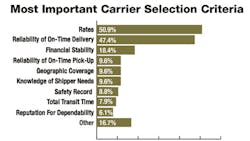Chief supply chain officers are used to hearing about the need for collaborating with their key supply chain partners, as this best practice is widely touted as a competitive advantage. Maybe so, but when push comes to shove, supply chain professionals are making their transportation decisions the old-fashioned way: rate shopping.
According to a survey of manufacturers, retailers and wholesalers/distributors conducted by the National Shippers Strategic Transportation Council (NASSTRAC), slightly more than half (51%) of respondents say the most important criterion when selecting a transportation carrier is rates, with reliability of on-time delivery a close second at 47%. The financial stability of the carrier came in third (18%); no other choice got more than 10% (respondents were asked to name their top three criteria; see chart below).
See Also: Lean Supply Chain Logistics Best Practices
The study also reveals that 79% of manufacturers have shifted freight from one transportation mode to another, with a shift to rail/intermodal -- the least expensive domestic mode -- being the most popular choice (38% of respondents). The least popular modal shift strategy is air freight (1.8%). Of those companies preferring to stick to motor carriers and their door-to-door level of service, there is a distinct shift to full truckload, a less expensive option than less-than-truckload (LTL).
When it comes to technology adoption, 42% of respondents are using transportation management solutions to gain an edge, particularly in the areas of route optimization and shipment aggregation.
And by far the biggest concern for shippers when it comes to legislative issues is the Hours of Service regulations for truck drivers (50% of respondents), which will reduce the amount of time drivers can be behind the wheel. It's anticipated that these new rules, set to take effect on July 1, 2013, could lead to the one-two punch of higher freight rates and reduced carrier service.




